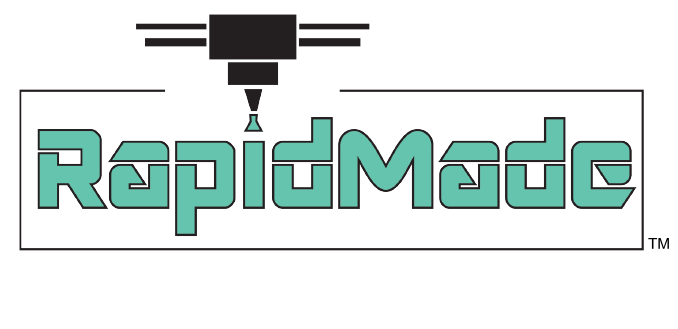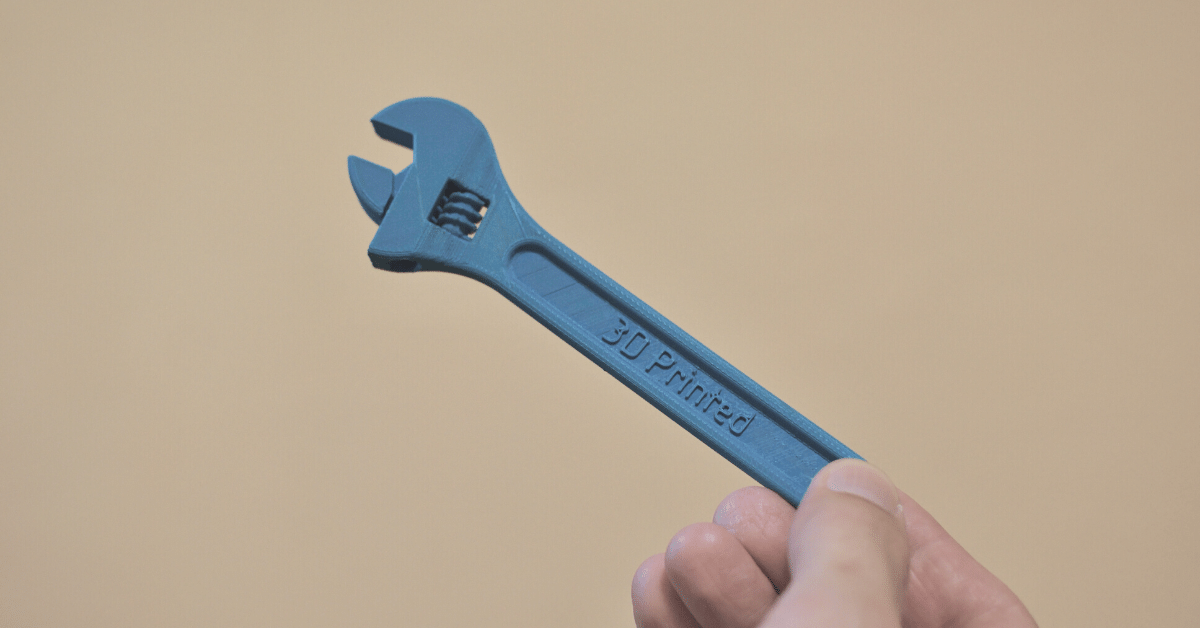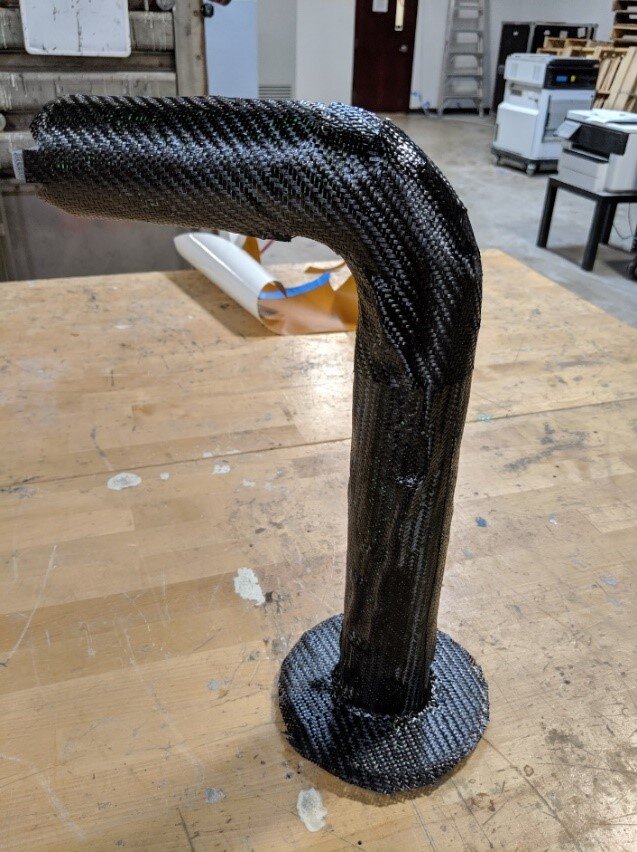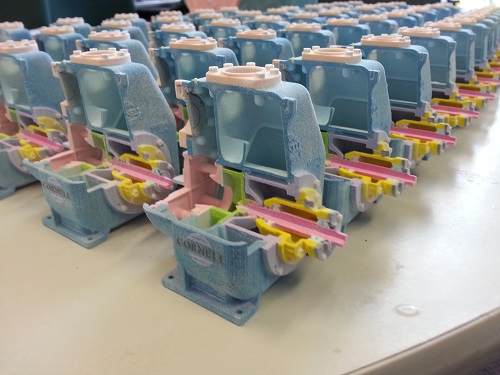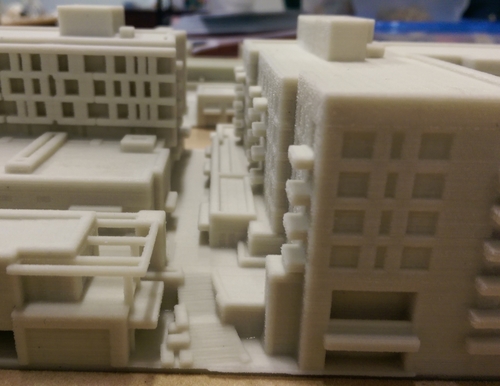AM Forward seeks to encourage the uptake of 3D printing by small and mid-sized enterprises. The goal? To help secure supply chains and recharge the manufacturing industry.
5 Benefits of Part Consolidation with Additive Manufacturing
Pre-Printing Checklist: How to Ensure Your 3D Model Design Is Ready for Print
3D Printed Tooling Is Revolutionizing the Manufacturing Industry
RapidMade Masks Help You Face Flying
One of the most anxiety-ridden activities these days is flying. Even if face masks weren’t mandated, most travelers would gladly wear them to enhance their personal safety. In locations where physical distancing is more difficult, people often prefer something more robust than a simple cloth mask.
Our thermoformed, filter-based face masks were enthusiastically worn by one family on a recent flight.
These masks gave us the peace of mind we needed to fly during the COVID pandemic! The masks fit snugly, but are easily breathable. We wouldn’t have flown without the security these masks provided!”
These reusable face masks can be thoroughly sanitized between uses, and the filters can be replaced as needed. If you’d like to order, please click here.
RapidMade Develops Techniques to Strengthen 3D Printed Nylon Parts with Reinforced Fibers
Carbon-fiber-reinforced 3D Printed Nylon Part
RapidMade recently completed research on investigating a solution to produce custom agricultural parts from 3D printed nylon reinforced with fibers in epoxy polymers. The work was completed with Oregon State University and was funded with an SBIR grant from the USDA.
Additive manufacturing reduces the cost and lead time of individually produced parts. Most printed plastic materials lack the strength needed to replace metal parts. Synthetic and natural fiber reinforcement can increase the strength of these lighter plastic parts making them comparable to metal. Well characterized design and manufacturing processes are critical to produce reliable composite parts.
Research focused on:
· structural component designs including materials selection
· pilot manufacturing process development
· manufacturing and mechanical component property validation.
Outcomes identified possible techniques for component design and manufacture to:
· eliminate plastic part anisotropy
· control warp and residual stresses in composite components
· verify plastic/epoxy bond strength
· optimize print orientation
· improve fiber reinforcement application
· establish curing cycle and post-processing requirements.
Future research will study part design techniques to:
· determine best practices
· create structural and processing analysis rules
· explore different material options
· optimize manufacturing processes for small batch production
· evaluate aging and environmentally induced stress responses.
Component design and manufacture showed positive results in terms of low-cost manufacturing process and performance. Fiber-reinforced parts performed better than the plastic-only reference components with strength comparable to the original metal parts. Data suggest that a reliable method for engineering and manufacturing fiber reinforced composites using printed parts was found. Proof-of-concept agricultural and robotic parts that can replace obsolete and custom equipment were shown to be potential affordable alternatives to the originals. Design aspects like matching plastic core and fiber reinforcement characteristics for optimal final composite products need to be addressed in detail.
New composite alternatives can be used to:
· make replacement parts
· increase field productivity
· upgrade or reconfigure machinery
· improve equipment operations and efficiencies
· manufacture components using more sustainable materials
· enable local farms to be more independent in part procurement.
This manufacturing process can enable small production plants to make parts locally as needed. Future work should build on current results by studying custom design, materials selection, manufacturing process optimization and aging and environmentally induced stress responses. Specifically, research focused on bonding reliability between printed parts and fiber reinforcement and combining components in a simple, efficient composite manufacturing process.
Work was subdivided into the following areas:
Mechanical Properties and Anisotropy of 3D Printed Parts. Baseline tests measured printed part mechanical properties prior to testing composite fiber components. ASTM standard tests of mechanical properties and microscopic analysis across a range of printers identified part anisotropy. Print parameters were established to limit anisotropy. Additional design parameters must be developed to limit impact on composite part performance.
Characterization of the 3D Printed Plastic-Fiber Reinforcement Epoxy Bond. Detailed bond tests were performed on parts made using two different fabrication techniques and three alternate fibers. Single lap joints were shear tested to failure to study nylon composite bond response. Multiple test scenarios characterized the nature of the bond, the minimum overlap requirements and the relative results with different fiber materials. Part failure occurred before the bond confirming the hypothesis. Actual bond strength data was captured. The use of organic fibers as an alternative lower cost composite reinforcement was confirmed.
Composite Manufacturing Process Evaluation. An established composite manufacturing process employed for small batch production was used for testing. Research focused on adapting these techniques to printed materials. Successful composite test parts were created and used for mechanical properties testing. Elements of the composite manufacturing process were investigated to improve the epoxy-nylon bond and to minimize component stress during heat curing. Trials were conducted to further simplify manufacturing techniques and optimize part quality. Work focused on three test components and three alternate fiber reinforcement materials. Iterations evaluated manufacturing process and part quality improvements. Findings were summarized in the published research.
Warping of Components During Curing. The effects of bonding between thin wall printed parts and fiber reinforcement using different configurations was studied. Thin wall components and the ability to assemble larger composite parts from multiple smaller printed parts are critical requirements for farming applications. The work focused on composite cooling times and fiber direction. Non-traditional inverse core sandwich constructions were also studied and tested. Results were positive; additional work will focus on further internal part stress reduction.
Design of Fiber-reinforced Test Components: Three designs were tested: a tractor linkage arm, a compound moment arm and a robotic fruit picker. These parts were selected as they experience different operational compressive and tensile stresses. The fiber reinforced parts were dimensionally comparable to the original metal parts. Mass reduction and low-cost manufacturing were assessed.
Construction and Testing of fiber-reinforced, 3D printed composite parts: Baseline finite element analysis for loading and elastic deformation simulations was performed on part designs. Unreinforced printed parts were mechanically loaded and tested; experimental results were compared to the simulations and test part baselines were created. Loading tests were repeated using fiber reinforced composite parts to characterize mechanical property augmentation due to fiber-reinforcement and the overall part performance. Extensive testing was conducted on all three parts using a range of fiber materials. The results were cataloged and contrasted to establish performance models. The work also analyzed the impact of composite construction methods on finished part mechanical properties.
Impact of temperature cycling on fiber-reinforced, 3D printed composite parts: Cyclical temperature tests performed on all parts using multiple fiber materials determined fiber bonding impact. This work measured bonded composite delamination using non-destructive test methods. Results confirmed that printed part design and fiber reinforcement location can impact composite bonding in response to thermal stress. Minimum printed part thickness must be determined to minimize warping, during the initial curing process and in response to subsequent thermal stress. Printed parts need to be designed and manufactured to account for internal thermal stress factors. Design techniques to improve part structural strength properties need to be included in future work. Finally, reinforcing composites should be selected to have a coefficient of thermal expansion that matches the printed core to minimize thermal stress warping.
To read the complete technical research report go to https://www.rapidmade.com/resources
Join Oregon Chapter of Women in Manufacturing Networking Night
End your day with appetizers, refreshments and conversation!
Join WiM Oregon for our upcoming Networking Night. This is a great opportunity for manufacturing professionals at all levels to network over appetizers, and to discuss December fundraising opportunities for WiM Oregon.
No matter what level you are in your manufacturing career, we look forward to meeting with you.
Date:
Tuesday, November 12
Time:
5:00 PM - 7:00 PM
Location:
Delap LLP
5885 Meadows Road
Lake Oswego
We hope to see you there!
Student: Free
WiM Member: Free
Nonmember: Free
Oregon Chapter of Women in Manufacturing Shares Safety & Ergonomics Best Practices
WiM members enjoying the view before dodging rare Portland thunderstorm
The Oregon chapter of Women in Manufacturing hosted a panel discussion on Safety & Ergonomics, led by Sherwin WIlliam’s Purdy management team. In addition to participants sharing best practices, the event’s highlights included refreshments and networking on a Portland rooftop garden, enhanced by city and river views. Attendees especially enjoyed the magnificent thunderstorm which entertained everyone during their meal.
Upcoming events will include a financial presentation hosted by DeLap LLP, a local CPA firm and a tour and talk on 3D printing hosted by RapidMade, a Portland-based additive manufacturing company.
Contact Renee Eaton at reaton@rapidmade.com for more information about the Oregon WiM chapter.
Participants share safety and ergonomic best practices
Join WiM Oregon for a Lively Discussion on Workplace Safety & Ergonomics
WiM Oregon is hosting a dinner and roundtable discussion on Wednesday, June 26! Join us for a roundtable discussion concerning safety and ergonomic issues and best practices in the manufacturing environment.
The event will include dinner, refreshments, and networking with industry professionals. We hope to see you there!
Date:
Wednesday, June 26, 2019
Time:
5:00 p.m. - 8:00 p.m.
Location:
Vista Pearl
1150 NW Quimby Street
Portland, OR 97209
Pricing:
Student: $10
Member: $15
Nonmember: $20
Registration includes dinner and two drink tickets.
Why Design for Additive Manufacturing (DfAM)?
Additive manufacturing, also known as 3D printing, has rewritten the rule book for modern design and engineering. 3D printed parts are durable and inexpensive at low volumes. They:
Achieve previously impossible complex geometries
Do not require any tooling or other start-up expenses
Reduce initial production costs
Enables on-demand manufacturing
But the best design practices for traditional manufacturing technologies do not apply directly to additive manufacturing, and, in fact, can prevent users from getting the greatest value out of their 3D printing operations.
To Design for Additive Manufacturing (DfAM):
Start early in the Product Development cycle to include the benefits of AM
Factor in mechanical differences; 3D printing can produce shapes not possible with injection molding or machining.
Design latticed interior structures to reduce part weight and volume without sacrificing strength
Change part orientation to manipulate part rigidity levels
Think about ways to increase build density to increase part quantity and cost.
Design for Additive Manufacturing Workshop with HP and RapidMade
Learn how innovative design and HP Multi Jet Fusion 3D printing can improve part quality, reduce costs, and speed up production.
Where: RapidMade | 15883 SW 72nd Ave, Tigard, OR 97224
When: Tuesday, April 9th, 2019 | 9AM - 4PM
Additive manufacturing is rewriting the rulebook for product design, which is why RapidMade is teaming up with HP for a free all-day event about design for additive manufacturing (DFaM) on the HP Multi Jet Fusion. Engineers and product designers are invited to join us for a special workshop led by additive manufacturing experts to learn more about how to get the most from 3D printing.
Here's what you'll learn:
Why HP used the Multi Jet Fusion instead of injection molding to manufacture over 140 functional parts used in each of its new MJF 500/300 3D printers
Identifying applications for additive manufacturing across your product lifecycle
Training on the fundamentals of effective design for MJF
Design strategies for MJF process optimization
How the materials behave and what to consider when designing for each of them
New design paradigms for additive manufacturing and the required mindset change
Designing for value maximization (process and cost)
Training on the fundamentals of effective design for MJF
Live Design for Additive Manufacturing (DfAM) demo and application examples to inspire you
This free event will feature breakfast and lunch, as well as the opportunity to tour our facilities and consult directly with specialists from RapidMade and HP.
Don’t miss out on this exciting opportunity! Registration is limited, so click the link below to reserve your spot today.
REGISTER HERE
Agenda
8:30 – 9:00 AM Breakfast
9:00 – 9:15 AM Welcome & introduction
9:15 – 9:45 AM Multi Jet Fusion (MJF) basics
9:45 – 10:15 AM Why 3D & case study of HP's adoption of Multi Jet Fusion technology for production parts
10:15 – 10:30 AM Break
10:30 – 11:30 AM Deep dive on designing for additive manufacturing – strategy, guidelines, materials, considerations, machining & threads, bonding, process control, etc.
11:30 AM – 12:00 PM Cases for tooling and final part production – urethane casting, thermoforming, fluidics management, industrial applications & electric vehicle examples
12:00 – 1:00 PM Lunch
1:00 – 3:00 PM Applications discovery workshop
3:00 – 4:00 PM Consult with HP and RapidMade experts on your parts
We look forward to seeing you!
Can't attend?
Get in touch with our 3D printing experts here.
University of Pittsburgh Awarded Grant to Improve 3D Printing of Tungsten Carbide
Carbide Parts provided by General Carbide Corporation (photo chredit University of Pittsburgh)
My alma mater in home town Pittsburgh continues its research in additive manufacturing. One of its latest projects involves evaluating the effectiveness of binder jet 3D printing technology to produce robust tungsten carbide parts. Researchers hope that binder jet-based 3D printing will overcome a challenge often encountered in fusing layers by “energy beam-based 3D metal printing” which can cause part failure due to rapid heating and cooling.
Pitt’s industry partner is General Carbide which is located in Pennsylvania. While the partners don’t specifically identify the 3D printer being used, researchers can be seen gathering around an ExOne (headquartered close to Pittsburgh) printer, so that would be a logical choice. Good luck Panthers.
Women in Leadership Forum Prompts Lively Discussion
RapidMade’s CEO Renee Eaton recently spoke at the University of Portland’s Women in Leadership Forum. The event “connects UP students with women who are leaders in the greater Portland community. The forum is a place for sharing stories, building connections and supporting” leadership development.
As a former university instructor at UP’s business school, Renee was thrilled to return to campus, catch up with former colleagues and meet with students, faculty and staff. She described her career path, lessons learned and starting a business in 3D printing (additive manufacturing) and engineering services.
RapidMade Presents at NW Electronics Design & Manufacturing Expo
Alex Nolan, RapidMade Sales, explains Additive Manufacturing options to NEDME participants
Mark Eaton, RapidMade’s VP of Sales and Marketing presented at the NW Electronics Design & Manufacturing Expo where he spoke about 3D Printing technologies and Additive Manufacturing’s evolution into final part production as a solution to short-run, custom manufacturing.
Recognizing that 3D printing is a means to an end, RapidMade’s team works to understand customers’ priorities to determine whether Additive Manufacturing is appropriate, and if so, which technology is the best fit. Regardless of the technology employed, additive manufacturing is redefining the ways in which things are made. We’re moving from mass, overseas production which requires extensive inventories to mass, localized customization which involves managing electronic files. Advances in materials allow a transition from metal to plastic finished parts. And with the introduction of HP’s Jet Fusion printer, the process dramatically reduces lead times and costs.
Contact us to learn more.
Display Your Way to Generate More Business
Capture your customers' imagination with creative, one-of-a-kind displays and models.
Pump cutaway model shows off internal components of Cornell Pumps
Marketing
- Get your products in front of customers where it would otherwise be difficult or impossible.
- Customize marketing materials with logos and designs.
- Infinite customization to achieve the exact effects you desire.
- Get concept models in front of customers early in the product development cycle to get feedback before spending too much money on the wrong track.
- Get tangible products in your customers hands instead of a 2D computer image.
Custom promotional giveaway for "Red Bull Guest House" party in Florida
Promotions
- Pens and magnets are boring and forgettable. Make a promotional giveaway your customer has never before seen.
- Come to us with nothing but an idea for a promotional product and we can take care of the rest.
- Personalize your giveaways to the exact customer you are handing it to with custom messaging.
- Many promotional products require expensive tooling and long lead times to accomplish - RapidMade can make your promotional products in a week or less.
Colored graphic blocks used by Amazon Web Services to explain its cloud services to prospective customers
Displays
- Drive traffic to your stores at the window and sales with custom retail displays.
- Stand out and get attention at your next trade show with eye catching models.
- Capture your customers' attention and make them remember your brand
- Lean on our design team to come up with a creative solution that will satisfy your customers and be flexible for your budget.
Reproduction of 3D scanned priceless Native American mask printed for Seattle Art Museum
Exhibits
- Store geometric and color data for priceless artifacts and works of art permanently with 3D scanning technology.
- Use digital object data to engage visitors online with interactive web exhibits.
- Create to-scale or re-scale replicas that let your visitors safely interact with models of priceless artifacts without endangering the original piece.
- Create complimentary pieces for your exhibit from object data scanned by other museums around the world.
Development model shown to Portland City Council for project approval
Architecture
- Turn around in as little as 24 hours means more time to perfect your designs.
- Embedded textures lets you simulate the colors of building materials like brick, stone and wood.
- Small features lets you design realistic windows, doors, beams, facades and other important visual design elements.
- Prints come directly from your BIM models.
How can we help you?
Dragons Return to Merry Ole England, Thanks to 3D Printing
Photo Credit: 3D Systems
A favorite perk of living in England was access to some of the greatest landmarks on earth. One such treasure was a mere 20-minute train ride away. Kew Gardens in Richmond is home to the Great Pagoda
“commissioned in 1761 during the reign of King George III... the striking 163-foot structure with its ornate and highly fashionable Chinoiserie style”
Atop its magnificent roof once stood 80 fierce wooden dragons that were removed, but not forgotten, in a 1761 renovation. Now they are being lovingly recreated by the magic of 3D scanning, reverse engineering and 3D printing - hopefully before our next "trip across the pond."
Jet Fusion Makes 3D Printing Faster and Affordable
What do custom dog helmets, human prosthesis, phone cases and machine parts have in common? They are being 3D printed overnight on an HP Jet Fusion at a fraction of the time and cost of older additive manufacturing technologies - without compromising quality...
- Lowest cost plastic (Vestosint PA-12)
- High strength
- Heat and chemical resistance
- Durable
- Wide range of composites and polymers
- Structurally sound
- Lightweight
Why compromise? Ask us how we can meet your prototyping and production needs.
3D Printed Periscope Phone Case Allows Everyone to be a Photo Pro
Defox has launched its Periscope Case, a novel phone case that uses mirrors and straps to transform one's smartphone into a versatile, easy-to-use camera that enables active photography. Manufactured in Portland, Oregon, Defox is using RapidMade's new HP Jet Fusion 3D printer to produce the cases in sturdy nylon. Act now for the early bird discount!
3D Printing Advocate Shares "The Practice of Innovation"
Jan Baum to discuss Additive Manufacturing at Stevenson University's Dell Lecture (photo credit: What Weekly)
I worked and lived in Maryland just as 3D printing was gaining public acclaim. There was a vibrant and supportive Additive Manufacturing community, centered in Baltimore, most often led by Jan Baum. An early adopter and advocate, Jan recognized the power of 3D printing to transform manufacturing, and she promoted its adoption as a way for Maryland to solidify its position as a premier manufacturing base that would allow it to offer high-skilled workers a secure income.
I'm pleased to see that Jan, the founder and director of Object Lab and a professor at Towson University, is still actively spreading this important message. Jan is one of the first (and most engaging) professionals I met during my tenure in Maryland. I loved that she was a female role model in a traditionally male field.
She'll be discussing "The Practice of Innovation" at the SOLVE Center on March 21 at 5 PM.
RapidMade Helps Firms Complete Year-End Project in Days, Not Months...
Every holiday season, purchasing agents and design engineers everywhere feel pressure to complete capital projects before they can celebrate the New Year. Who wants to forfeit hard-earned budget allocations because time constraints prevent delivery before the 2018 count down? Make your holidays happy instead.
Thanks to Additive Manufacturing (3D printing), year-end projects can be completed in days, not months. Services include:
- Rapid Prototyping
- 3D Scanning
- Production Parts
- Thermoformed Products
- Reverse Engineering
- Industrial Patterns
- Printed and Machined Tooling
- Custom Displays, Exhibits and Promotions
- Engineering Design
Additive Manufacturing benefits:
- Short lead times
- No tooling costs
- High customization
- Small-batch production
- Eliminated design limitations
- Pre-built assemblies
- Reduced structural weight
